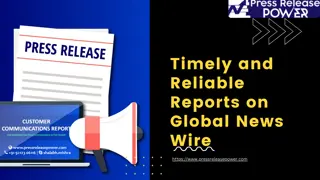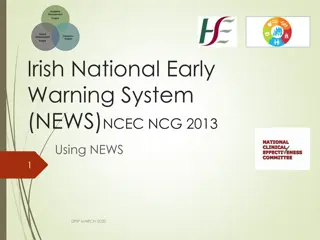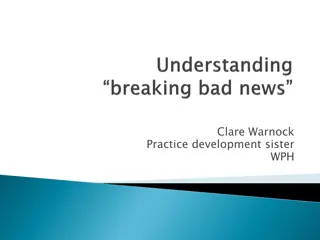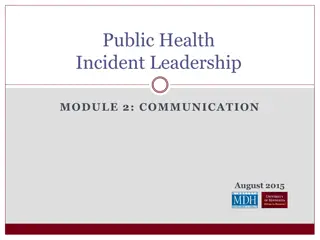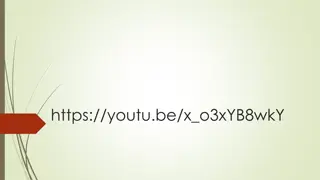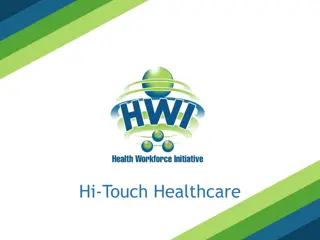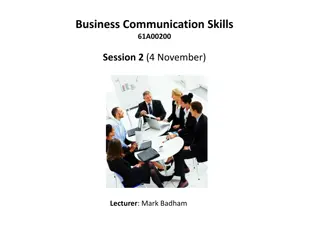Effective Communication & Breaking Bad News in Healthcare: Strategies and Models
Explore the importance of effective communication in delivering bad news in healthcare settings, including understanding different models such as SPIKES and ABCDE BREAKS. Learn how to navigate the stages of breaking bad news with empathy, clarity, and understanding to better support patients and their families.
Download Presentation

Please find below an Image/Link to download the presentation.
The content on the website is provided AS IS for your information and personal use only. It may not be sold, licensed, or shared on other websites without obtaining consent from the author.If you encounter any issues during the download, it is possible that the publisher has removed the file from their server.
You are allowed to download the files provided on this website for personal or commercial use, subject to the condition that they are used lawfully. All files are the property of their respective owners.
The content on the website is provided AS IS for your information and personal use only. It may not be sold, licensed, or shared on other websites without obtaining consent from the author.
E N D
Presentation Transcript
Effective Communication & Breaking Bad News WCB Wales Eyecare Conference 22.11.23
Communication & Breaking Bad News Broken down into 2 different stages Why is communication important to me? 3 different models of Breaking Bad News (BBN)
Introduction Introduction Introduction What is Bad News? Bad news by any diagnosis that negatively alters the patients view of his or her future. Oncologist Robert Buckman co-founder of SPIKES method Bad News is always in the eye of the beholder For example a patient who is told their blurry vision is from Wet AMD rather than just needing a stronger pair of glasses.
Famous sayings about communication The patient will never care how much you know, until they know how much you care Teddy Canale on his American Academy of Orthopaedic Surgeons Vice Presidential address People will forget what you said, people will forget what you did. But people will never forget how you made them feel . Maya Angelou, American Poet & Civil Rights Activist
Breaking Bad News models Breaking Bad News Breaking Bad News Models Models SPIKES developed by Oncologists Robert Buckman & Walter Bailie in 2000. This the Model used in GP training by Royal College of General Practitioners and other HCPs ABCDE BREAKS
S P I K E S SPIKES S Setting Do you have enough time, is this the right place? Mental rehearsal, how will respond to negative emotions P Perception How much does your patient know and understand I Invitation for Information K Knowledge, Is the information sufficient and clear E Empathy What is the impact of what you say and how you say it S Summary/Strategy: do you check for understanding
Setting Setting Involve significant others, family members especially for cognitive issues- Do you have anybody with you today or Two memories are always better than One Sit Down/Stand Up mirror other persons position, be at eye level when communicating Look Attentive and calm Eye Contact Listening Mode: Active Listening vs Passive Listening
Perception Perception What did you think yourself? What have you been told so far? Do you know the reason why I brought you back today? Are you worried that this might be something serious?
Invitation Invitation Are you the type of person who wants to know all the details or just the major ones? How much information would you like me to give you about the diagnosis and its treatment? Would you like some patient information leaflets? Would you like me to recommend some good websites to look at?
Retained Information Numerous studies have been made talking about the amount of medical information that is recollected by a patient. Greater the amount of information = the lower the proportion is recalled.
Patients Memory for Medical Info , 2003, R P C Kessels, JRSM Amount of Medical Information that is forgotten? Amount of info that is remembered that is incorrect? Percentage of Spoken Info remembered correctly? Percentage of written/Pictorial info remembered corectly?
Patients Memory for Medical Info , 2003, R P C Kessels, JRSM Amount of Medical Information that is forgotten? 40-80% Amount of info that is remembered that is incorrect? 50% Percent of Spoken Info remembered correctly? 10% Percent of Written/Pictor info remembered correctly? 80%
Patient Engagement Strategies Patient Engagement= Act of patient & provider working together toward an end gal of improved patient wellness. Verbal Dominance= provider speaks more than the patient= a lower patient recall rate Patient Teach Back- Explain medical information, treatment options, or self-care instructions to patients. Then you ask patients to repeat the info in their own words. Low Cost, Low Technology Intervention
Knowledge Knowledge Unfortunately I ve got some bad news for you Mrs. Smith, I m so sorry to have to tell you this Pause wait for them to take a breath Use short simple clear sentences Avoid medical jargon- assume minimal Health Knowledge
Empathetic Statements Empathy How does that make you feel? I can see how difficult this is to take in That must be terrible for you! I can totally see why you would be upset I m sure some of this news must come as a shock to you
18 people diagnosed with eye disease 4 main themes 1) The convoluted process of being diagnosed- frustration & anxiety 2) The impact of the clinicians words 3) The search for information- untrusted sources, dodgy websites 4) Reflections on what could be improved- person centred approach
Impact of the Clinicians words Long term adjustment to a disability is more effective when the new is given in a positive, empathetic manner. Understand how the clinicians words & actions are understood, it impacts a patients ability to come to terms with their condition and are often recalled years later. Patients who felt pitied had a negative view of their diagnosis compared with a more positive outlook for patients who were admired for how well they are coping Tone of Voice- not callous, not condescending
Empathy 3 ways how to show Empathy Put yourself in the patients shoes and see the world from where they are sitting 1) Improving your listening skills give undivided attention, get rid of distractions 2) Let the person speak without interrupting them- it is a sign of Respect. GP Timing 3) Eye Contact- be aware of cultural sensitivities and autism spectrum may feel threatened by it






